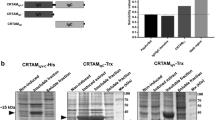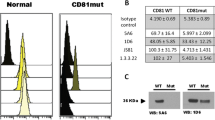Abstract.
Proteins of the CD2 family belong to the immunoglobulin (Ig) superfamily of receptors that are expressed predominantly on hematopoeitic cells and function to modulate immune responses. The present study characterized a new member of the CD2 family, designated Ly108. The Ly108 gene encodes a protein of 331 amino acids, including a putative leader peptide, an extracellular region consisting of two Ig-like domains, a hydrophobic transmembrane segment, and a cytoplasmic tail of 69 amino acids. An alternatively spliced transcript, whose encoded protein differs only in the cytoplasmic domain, was also identified. Like other CD2 family members, the extracellular region of Ly108 also contains an N-terminal Ig variable region-like domain lacking any disulfide bonds and a membrane-proximal truncated C2-like domain with two conserved disulfide bonds. Overall, Ly108 is most similar to CD84 and Ly9, and the gene maps to the distal arm of mouse Chromosome 1, in the vicinity of CD48 and Ly9. Ly108 transcripts appeared to be expressed only in lymphoid tissues, and were readily detected in all but the most highly differentiated mouse B- and T-cell lines analyzed.
Similar content being viewed by others
Author information
Authors and Affiliations
Additional information
Electronic Publication
Rights and permissions
About this article
Cite this article
Peck, S., Ruley, H. Ly108: a new member of the mouse CD2 family of cell surface proteins. Immunogenetics 52, 63–72 (2000). https://doi.org/10.1007/s002510000252
Received:
Revised:
Issue Date:
DOI: https://doi.org/10.1007/s002510000252




